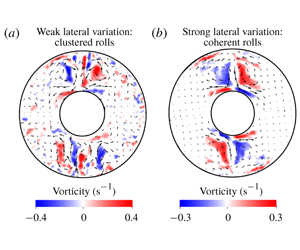Article contents
Convection in a rapidly rotating cylindrical annulus with laterally varying boundary heat flux
Published online by Cambridge University Press: 19 November 2019
Abstract

Convection in a rapidly rotating cylindrical annulus subject to azimuthal variations in outer boundary heat flux is investigated experimentally. The motivation for this problem stems from the influence of the laterally inhomogeneous lower mantle on the geodynamo. The absence of axial ( $z$) gradients of boundary temperature ensures that the condition of quasi-geostrophy, often used to model convection outside the tangent cylinder in spherical shells, is realized in a cylindrical annulus even in strongly driven convection. Experiments are performed with water from below onset of convection to highly supercritical states (measured by the flux Rayleigh number,
$z$) gradients of boundary temperature ensures that the condition of quasi-geostrophy, often used to model convection outside the tangent cylinder in spherical shells, is realized in a cylindrical annulus even in strongly driven convection. Experiments are performed with water from below onset of convection to highly supercritical states (measured by the flux Rayleigh number,  $Ra\sim 10^{10}$) and for boundary heat flux heterogeneity
$Ra\sim 10^{10}$) and for boundary heat flux heterogeneity  $q^{\ast }$ (defined by the ratio of the azimuthal variation to the mean boundary heat flux) in the range 0–2. The power requirement for onset of convection reduces substantially with increasing
$q^{\ast }$ (defined by the ratio of the azimuthal variation to the mean boundary heat flux) in the range 0–2. The power requirement for onset of convection reduces substantially with increasing  $q^{\ast }$, in line with earlier studies of the onset in rotating spherical shells. For strongly driven convection at
$q^{\ast }$, in line with earlier studies of the onset in rotating spherical shells. For strongly driven convection at  $q^{\ast }>1$, the long-time structure is that of localized coherent cyclone–anticyclone vortex pairs, which produce narrow downwellings between them. However, shorter-time averages of the flow reveal the presence of small-scale motions, which may have an important role in magnetic field generation. For a twofold heat flux heterogeneity of
$q^{\ast }>1$, the long-time structure is that of localized coherent cyclone–anticyclone vortex pairs, which produce narrow downwellings between them. However, shorter-time averages of the flow reveal the presence of small-scale motions, which may have an important role in magnetic field generation. For a twofold heat flux heterogeneity of  $q^{\ast }\approx 2$, convection within the annulus fully homogenizes at
$q^{\ast }\approx 2$, convection within the annulus fully homogenizes at  ${\sim}30$ times the onset Rayleigh number, and no coherent vortices remain. Finally, the measured heat flux variation on the inner boundary is considerably larger compared with that on the outer boundary, which provides a plausible mechanism for inner-core heterogeneity in the Earth.
${\sim}30$ times the onset Rayleigh number, and no coherent vortices remain. Finally, the measured heat flux variation on the inner boundary is considerably larger compared with that on the outer boundary, which provides a plausible mechanism for inner-core heterogeneity in the Earth.
Information
- Type
- JFM Papers
- Information
- Copyright
- © 2019 Cambridge University Press
References
- 5
- Cited by

